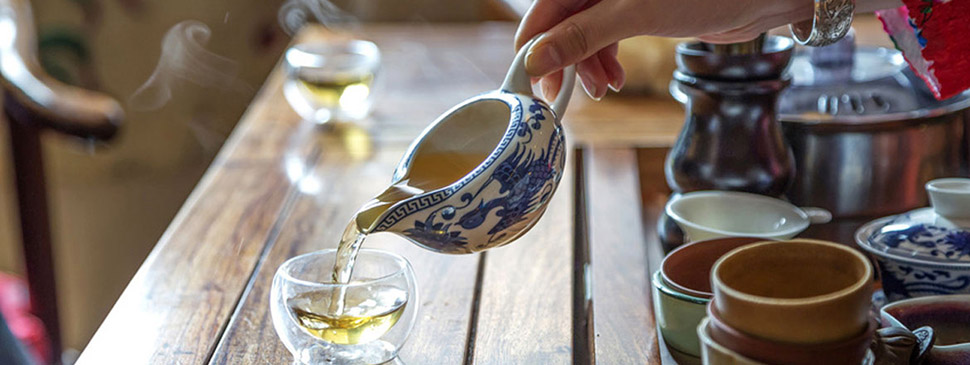The ritual of tea: preparation

Offering a cup of tea to welcome visitors and put them at ease is a ceremony that, even today, defines many oriental populations.
˜
Infusion time
The black teas of India and Ceylon require 3 to 5 minutes of infusion, except for Darjeeling First Flush, which needs 2 to 3 minutes, as do African black teas.
Chinese green teas are left to infuse for 2 to 3 minutes while Japanese teas vary greatly depending on the quality: for some 30 seconds are sufficient, for others no less than a minute and a half or two.
For Oolong teas, infusion time is between 2 and 6 minutes, while white teas require 2 to 4 minutes.
Today as ever, to prepare a perfect cup of tea it is essential to have quality raw materials, and the correct tools and techniques necessary to turn them into an exceptional drink.
Water and it's temperature
The water used for brewing plays a very important role in determining the quality and flavour of the tea. It is important to ensure that it is pure, colourless and odourless, ideally with a pH of 7. The components of the water such as minerals, chemical additives (such as chlorine and fluoride) and the quantity of oxygen all affect the final taste of the tea. Not surprisingly, there are legends that have been handed down of emperors of ancient China who had water brought from faraway, inaccessible places in order to ensure the perfect infusion.
The water temperature is also important when considering the quality of the tea. A kettle that regulates temperature allows one to obtain the perfect temperature. Too high temperatures may destroy some aromatic components of tea, however those that are too low prevent the leaves from release their aromas.
The teapot
Without doubt, the teapot is the emblem of tea. Enamel or porcelain teapots are ideal for delicate tea while terracotta ones are perfect for tea with a strong aroma because their porosity preserves the taste of previous infusions. In time, they are enriched with perfumes and aromas, which are then transmitted to the infusion. Today we find teapots fitted with removable internal filters, generally made of steel or porcelain, and even those made of glass or transparent perspex. There are also beautiful cast-iron Japanese teapots, which apparently release substances beneficial to our body when brought in contact with heat.
Filters and strainers
Their function is to filter the infusion to ensure that the leaves do not brew for too long, thus giving the tea too strong a flavour. They are generally made of metal or porcelain mesh with holes, but may also be made of bamboo, cloth or chlorine-free paper.
The cups
The English believe that the best container for drinking tea is their mug because it keeps the tea hot for a long time. The Chinese prefer small porcelain cups. The ideal cup is however a light, thin cup of one colour (white, jade green or china blue) to allow the infusion to draw. In the Far East today the ideal cup is of white porcelain. The gaiwan, the flared, covered cup from China, comes in various sizes and is used as a teapot for the preparation of the infusion.
Tea caddies
The best must be sealed and not transparent. Whether they are made of tin, steel or, even better china, they must guarantee the perfect conservation of the leaves, avoiding both the loss of aroma and dehydration. The opening must be sufficiently large and convenient to extract the tea without waste.
SAFE SHOPPING AND GUARANTEED QUALITY
Information
Business solution
Subscribe to our Newsletter
Iscriviti alla Newsletter e ottieni subito il 10% di sconto sul tuo prossimo ordineInformation notice pursuant to article 13 of the GDPR 2016/679. The data you provide by filling out this form will be subject to processing on paper and electronically and will be used only to subscribe you to our newsletter. Your data will not be communicated nor distributed to third parties. The data controller is Pompadour, which you can contact to exercise your rights, including the right to access your data or to consolidate, correct or delete it. To read the complete information notice, please refer to: our privacy policy.
You can unsubscribe from the newsletter at any time, either by sending a message to the contacts at the bottom of the page or by means of a specific link that can be found in each newsletter. After the cancellation, we will delete your e-mail address, unless you have expressly consented to further use of your data and save our reservation for further use of the data, use of which you have been corrected this declaration in compliance with the provisions of the law.
Cap. Soc. 500.000 Euro i.v. | Part. IVA e CCIAA 00122230212 | numero REA: BZ-58412
PEC: pec@pec.pompadour.it | Email: info@peters-teahouse.it | Tel: 0471 549 021





